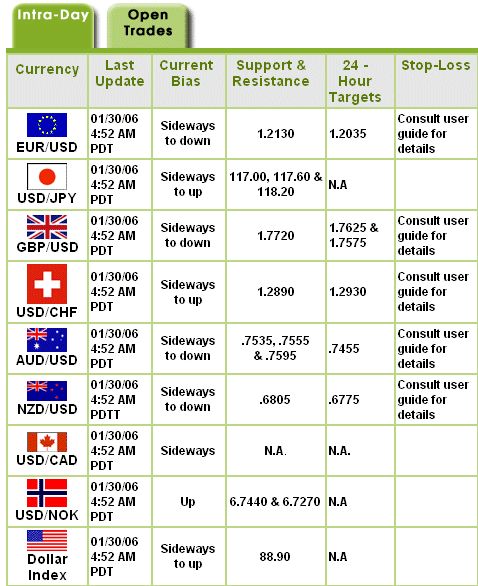Here’s the entry I’m looking for in the Dollar Index
Here Are Some FX Set-Ups I am Watching
 The Dollar Index (DXC) is following through
on the solid move higher from Friday – we see a range of 88.80 — 89.55. As you
will recall, the 89.55 level has been a very tough level to break.
The target prices noted below should provide
some ideal short-term trades. Please read through the ‘Notes/How To’ for
directions on using these.
Monday’s 24-Hour FX Targets

Performance Data
for 24-Hour Target Trades:
Pip count Week of Jan 2nd: 254 pips (Monday & Wednesday only)
Cumulative since Oct 10th: 2,159 pips
Â
Notes/How To for The 24-Hour FX Targets
Today’s FX traders are now demanding a more systematic
approach, and this new feature will nail those desires right on the head. With
our 24-hour forecasts you have specific entry prices, stop-loss and price
targets.
Entries: entry prices are meant
to be taken at the time of posting by simply placing an order to buy or sell at
the market. Targets will typically be posted by 5 AM PDT.
Stop-Loss: we suggest that all
traders place a stop-loss equivalent to ½ of the value of the projected gain in
pips. For instance, if the price target for the EUR/USD is 1.2200, and it is
trading at 1.2100 at the time (100 pip gain) of the forecast, we would suggest
setting a 50 pip stop loss (1.2050).
We also discuss a basic trailing stop strategy at the end of
this article.
Exits: traders should take
profits when the ‘Target Price’ is achieved. If, by 5 AM PDT the following day,
the stop-loss or target price has not been achieved, simply close the trade at
market.
Let’s look at an few example as a way to illustrate how this
will work. Below is a screenshot from Thursday October 20th, it is exactly the
same format that will be posted here each Monday and Wednesday.
Â

Â

GBP/USD went on to achieve both targets.
Naturally, not all of the forecasts will play out, and like
most systematic approaches, the number of iterations will increase your success.
Pairs like USD/JPY and EUR/USD did not achieve their targets and
were stopped out, resulting in a loss of 65 pips, while AUD/USD, USD/CAD
and USD/NOK easily offset the 65 pip loss with solid gains.
Â

Trailing Stops:
Traders may also look to employ a trailing stop strategy to
protect gains. We suggest using a trailing stop equivalent to 1/4 the value of
the targeted gains. So, in the example of the GBP/USD above, the target is for a
gain of 70 pips, therefore a trailing stop of 17 pips might be a prudent
approach.
Ultimately the decision is yours. Other traders/clients simply
use our forecast(s) as a guide and then identify their own entry points based on
their trading methodology.
As always, feel free to send me your comments and questions.
